
Whether we are looking for a good place to eat, to get our car fixed, or to buy a household item, online reviews have become an essential part of the consumer experience in the digital era. When faced with a decision, whether large or small, internet users increasingly value being able to take the unbiased opinions of others who have been in their position into account.
With that in mind, it’s worth considering just how much reviews of your school might influence your prospective students. Ensuring that you generate enough positive reviews, handle negative ones well, and are aware of all the different online spaces in which students, parents and other members of your community might be sharing their thoughts about your institution could make a crucial difference to your success.
Why Reviews Should be a Part of Your Marketing Strategy to Attract Students
According to a 2017 study from Spiegel Research Center, nearly 95% of shoppers read online reviews, while a survey conducted the same year by BrightLocal revealed that 85% of consumers trust online reviews just as much as a personal recommendation from someone they know.
While little extensive research has been done into just how much online reviews can influence the decisions of prospective students when researching schools, we do know that peer recommendations play a huge part in the decision-making process. For instance, the QS Digital Solutions International Student Survey 2018 found that positive reviews of instructors from existing students was the third most common factor prospective applicants took into account to gauge teaching quality.
In much the same way as student testimonials, independent reviews offer crucial ‘social proof’ to potential applicants, providing valuable evidence that your institution can deliver on its promise. Unlike curated testimonials, however, reviews which appear on independent online channels are unedited and uncontrolled by your school. They can be both good and bad, and either reinforce your key recruitment messages or contradict them. While it can make their impact unpredictable, this authenticity is what makes them so valuable. Simply put, prospective students trust reviews from independent sources, and are more likely to believe them.
Where is Your School Being Reviewed?
Online reviews for schools can come from several different channels, meaning recruitment teams need to be extra diligent in order to use them effectively to generate student leads. Here are a few of the most widely used and influential review sites:
Google My Business
First introduced in 2013, the reviews section in Google My Business listings has slowly but surely become an important part of search. The reviews section appears below the social media profiles in a standard GMB listing.
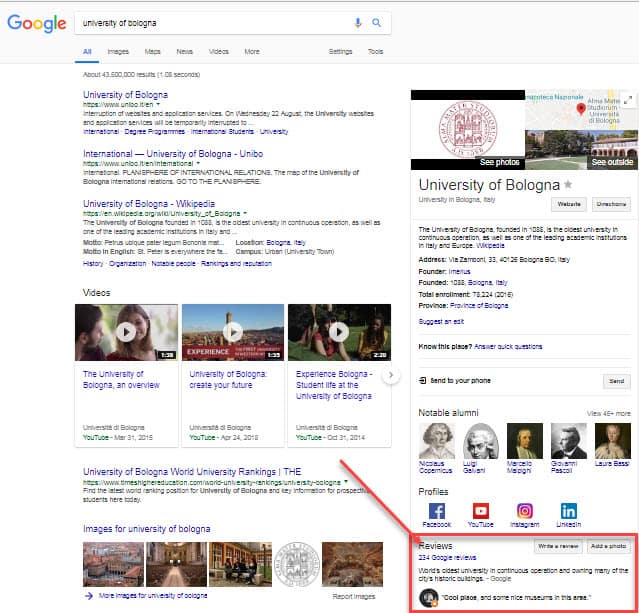
Google reviews are crucial because of the sheer volume of potential recruits who will see them when conducting branded searches for your school. Research from Moz has also found that the reviews you receive could have a big impact on local SEO:

According to the survey, reviews can be up to 7% of the overall signals that determine organic rankings at a local level, and up to 13% of the signals for Google’s local ‘pack’ ranking – the standard top three results that appear in their own box with a map in most local search results.
Example: The local pack for a search for language schools in Manchester.
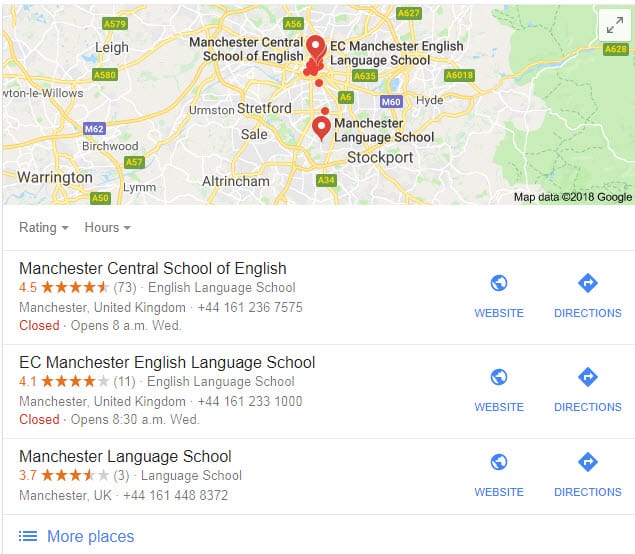
Yelp
Perhaps the platform most ubiquitous with online reviews, over 163 million entries have been written for Yelp since its launch in 2004. The site and app’s user-friendly interface and reputation for unbiased and informative feedback makes it extremely attractive for web users. Due to its name recognition alone, the site may well be the first port of call for any prospective students actively seeking reviews of your school.
Example: A sample of Yelp reviews for English Language Schools in London.
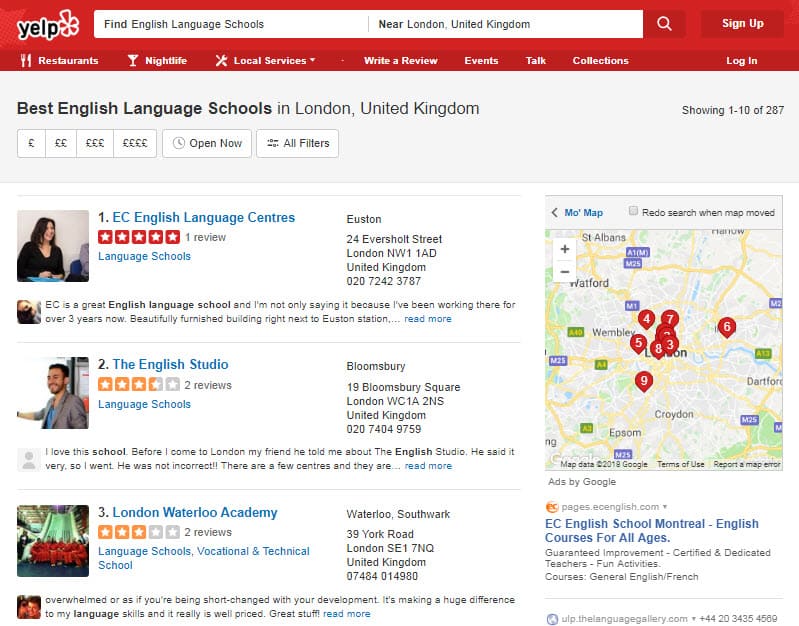
The demographics of Yelp’s audience also makes them highly desirable. According to the platform’s own figures, over 60% of users are college educated, 33.9% are aged between 18 and 34, and over 49% have an income of over USD$100k. Having said that, it’s important not to attach too much importance to the exposure your institution gets on Yelp, as schools comprise a relatively small fragment of what gets reviewed on the site:
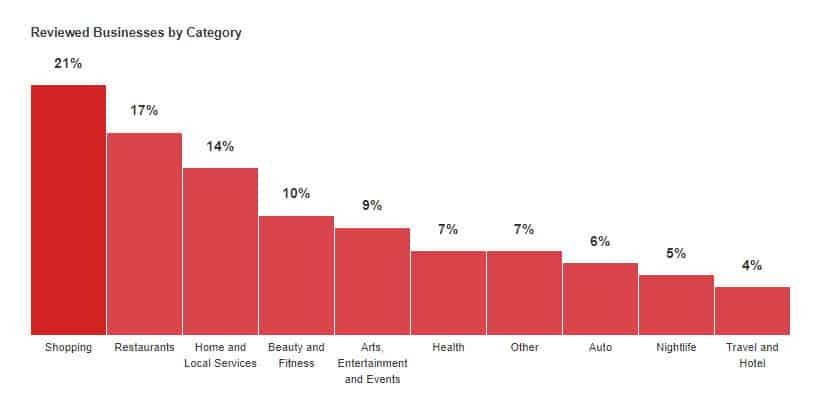
Most of Yelp’s reviews are devoted to the retail and restaurant sectors, and the company’s own figures don’t even include education as its own category, instead presumably grouping it under the ‘Other’ umbrella, which comprises just 7% of reviews in total. This means that, while having reviews on Yelp is undoubtedly a good thing, the actual traction schools might gain from it is limited.
Surprisingly, review functions aren’t that common on social media platforms at present, but Facebook’s reviews have become increasingly prominent. Located on both official business pages and in the Places section of the site, Facebook’s reviews are unique in that they offer a lot more opportunities for user interaction than other platforms. While it is possible to reply to posts on both Google and Yelp, Facebook allows you to do so using the site’s customary reaction buttons, as well as comments which can incorporate photos, gifs, stickers and emojis. The site’s natural reputation for engagement and conversation can also make users more likely to comment on reviews.
Example: A review for Rhodes Wellness College on Facebook which attracted a comment from another user.
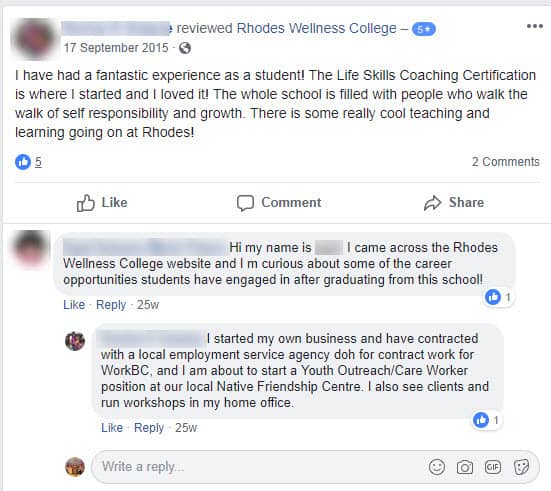
Another interesting aspect of Facebook’s reviews system is that it allows users to ‘recommend’ places by posting in their own newsfeeds about them. This can be a great way to amplify the effects of a positive review.
Example: This relative of an Oregon State University graduate took it upon themselves to recommend the university while posting photos of their graduation ceremony. Posts like this can be great for word-of-mouth recognition.

Facebook reviews also have an effect on your page authority in the site’s algorithm, meaning more reviews could mean better organic visibility for your school.
College Review Sites
In addition to these general options, schools also need to be mindful of a number of review sites designed specifically for education, such as CourseFinders, Student Hut, and many others. While the traffic and overall visibility generated by these sites is far less than the likes of Google, Facebook, and Yelp, their specific focus on the sector means they often provide more detail and a more customized view tailored to education, often allowing users to rate institutions based on specific factors like faculty and staff, affordability, and accommodation.
Example: The review page for Leeds Language Academy on CourseFinders. Note how the school is rated based on different factors, such as courses, facilities, and activities.
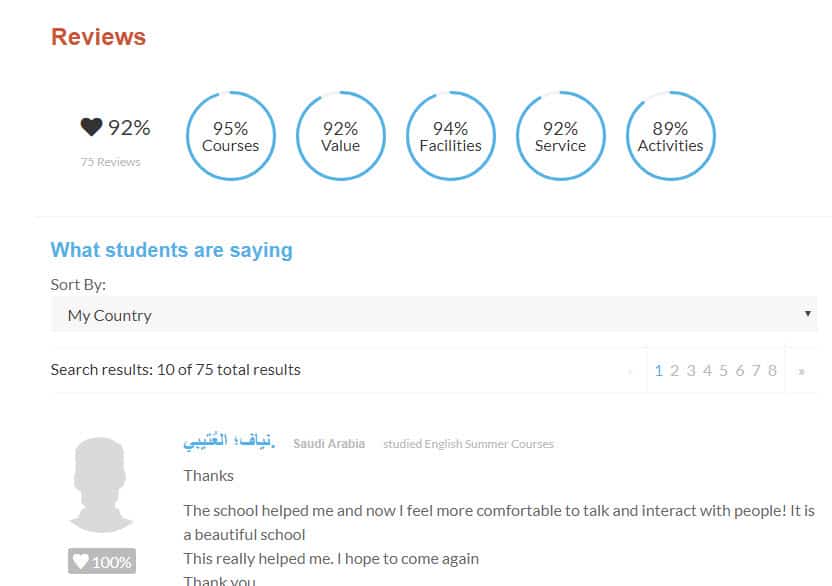
There are also sites that review faculty members as well as institutions themselves, such as Rate My Teachers and Rate My Professors, as well as those which focus on a particular sector of the education market. For instance, sites like Hotcourses Abroad and Go Overseas focus specifically on reviews and opportunities for international students.
Example: The Hotcourses Abroad reviews page for James Cook University in Australia.

How to Generate Reviews to Attract Student Leads
While the power reviews have on student lead generation is inarguable, actually getting them can be a challenge. BrightLocal suggest that people read an average of seven reviews before making a purchasing decision, while research conducted by Fan and Fuel in 2016 found that 73% of customers valued written reviews above simple star ratings. With that in mind, it may be well worth doing an audit of your presence on the above channels and seeing just how many reviews exist for your school on each, and how substantial they are.
Example: Herzing College Montreal has attracted 126 reviews on Google, an impressive amount for a school of its size. It also has a high average rating of 4.1 stars.
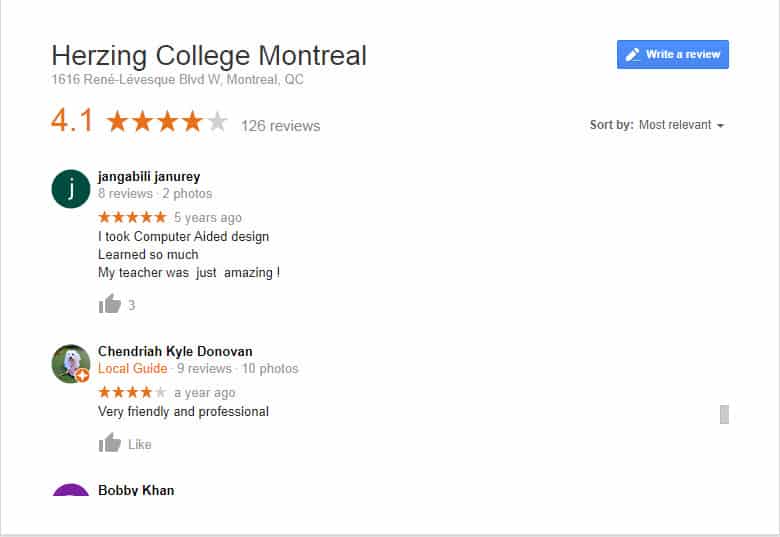
If you find that there aren’t many reviews of your school, or that they are too short or negative, you may need to be more proactive in seeking them from your online community. In addition, internet users will consider older reviews to be dated and less relevant, so continuously encouraging new reviews is advisable.
A good first step is to ensure that the information you’re presenting on each channel is fully up to date, and that it stands out to users. For instance, optimizing your Google My Business Listing with up to date information, images and GMB posts can be extremely helpful, as it will increase its chances of making the search engine’s pack rankings, thus making it more likely that people will see it in search and decide to write a review. Likewise, ensuring that your school can be found in Facebook Places rather than just via your own page will increase the likelihood of users reviewing it.
In addition, dedicated review sites like Yelp, as well as education review sites, will often allow you to claim ownership of your school’s page, usually for free. This means you can edit it to make it more engaging and ensure it provides all the information users browsing the site might need. Some, such as Go Overseas, even provide custom data dashboards which allow you to view valuable traffic and engagement metrics for your page.
Example: The Go Overseas page for IES Abroad’s Irish Studies program in Dublin includes a number of videos and colourful images from the course provider, as well as an engaging summary of what prospective students can expect.
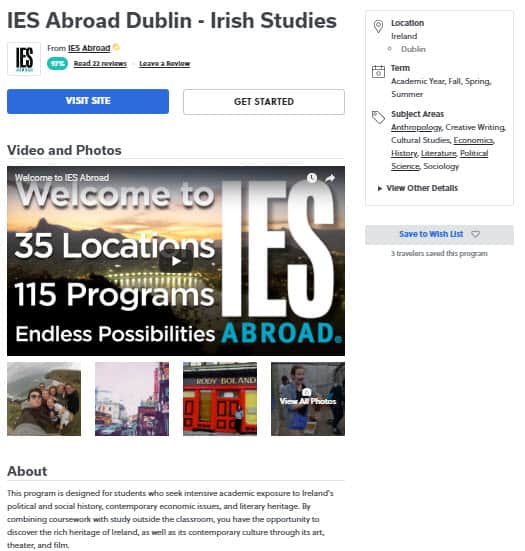
Actively soliciting reviews from members of your online community can also prove to be quite fruitful. Adding simple call to action prompts to your GBS listing or social media posts asking open-ended questions such as “What do you think of us? Let us know in the review section!” can be an easy way to get more users to write reviews.
Example: Redlands Packinghouse Christian Academy posted on Facebook to encourage its followers to write Google reviews of the school.
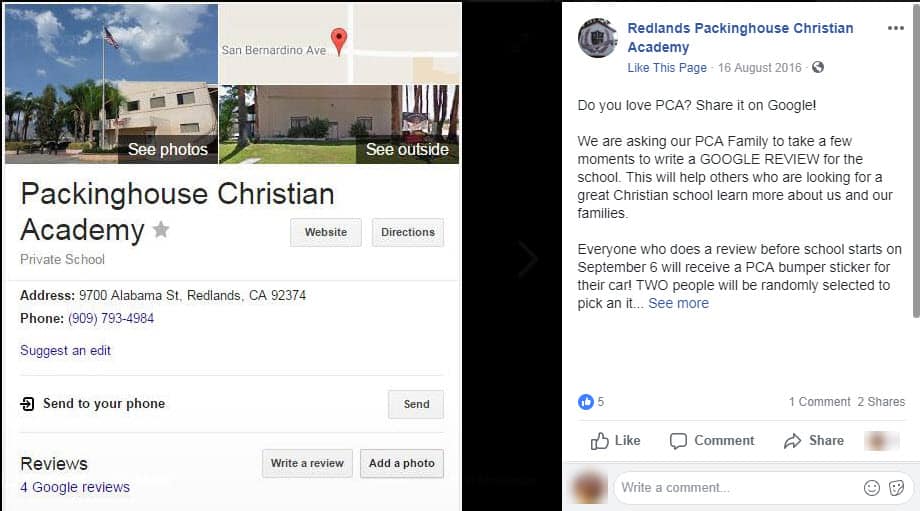
Furthermore, you can optimize your website to encourage more reviews from visitors. Yelp allow businesses to add a review badge to their web pages, and this can be included along with your other social media buttons in blog posts, program pages and other strategic areas of your site. Another good idea might be to create a CTA to solicit GMB reviews. This can be done relatively easily by finding your school’s listing and clicking on the ‘write a review’ button.
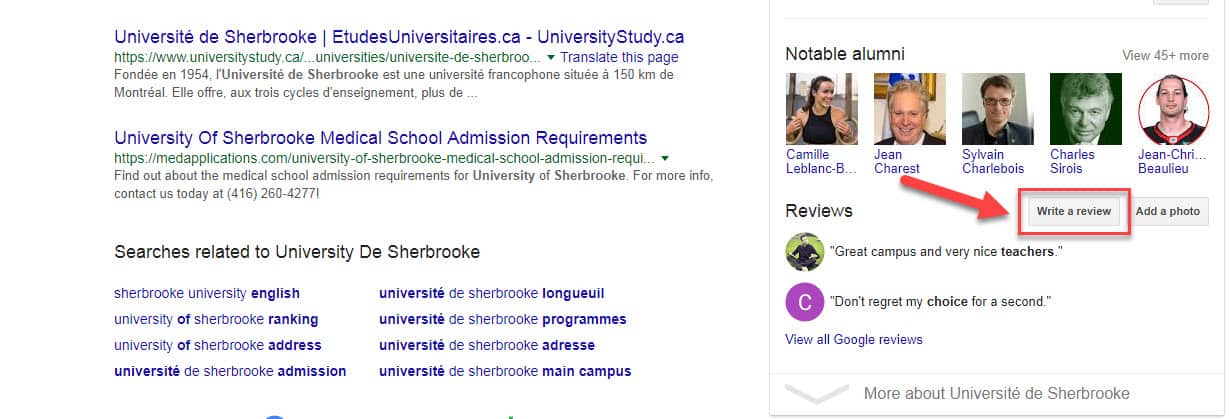
When you do, a pop-up box will appear, and you can simply copy the URL from this page and add it to your CTA. The button will automatically take users to the same page.

Alternatively, you can use an embeddable widget to add a review window on your web pages. In both instances, setting up proper tracking code and goals can allow you to measure the success of your efforts in Google Analytics.
Another approach to soliciting reviews is to ask users directly for them through email, instant messaging and texts. For best results, it’s important to do this at the right time. For instance, emailing current students around exam time might not be the best idea, but getting in touch with recent graduates a few months after they finish might provide the perfect opportunity for them to reflect on their experience with your school and how far they have come.
When you do begin to attract more reviews, it’s important to respond to them. Not only is this a good way to keep your online community engaged and included, it is also seen as a positive by sites like Facebook and Yelp, who rate the responsiveness of businesses. Demonstrating that you take an active interest in what your audience thinks will contribute to a favorable perception of your institution online.
Example: Bishop’s University makes a point of responding to reviews as often as possible.

If you get particularly glowing reviews, it may an idea to showcase them across your digital channels, either on your website or on your social media pages. Publishers like WordPress also provide plugins which allow you to create a scrolling display of reviews from sites like Google and Yelp on your site.
Example: CDL University LLC create unique pages for their positive reviews.

Responding to Negative Reviews About Your School
Sooner or later, your school will get a negative review. No matter how good your courses, staff, and support services are, there will always be a small number of people who, for whatever reason, did not get what they had hoped for from your institution. It could be a prospective student, a recent graduate, someone who had dropped out, or even a student’s family member or another person who had to engage with your school in some way and did not enjoy the experience.
While a bad review can be discouraging, it is not actually always a negative for your school. In fact, a study by Revoo showed that up to 95% of web users become suspicious of businesses which have no bad reviews, or whose reviews seem too glowing and unbalanced. This causes them to suspect that bad reviews have been censored, or even worse, that the organization may have written falsified positive reviews. While some channels do make it possible to remove negative reviews, it can hurt the authenticity of your brand and breed mistrust online. Unless the review uses obscene language or is otherwise offensive, it is best to let it be.
The key to countering negative reviews is to respond to them, just as you would to positive ones. Adopt a polite tone and acknowledge the concerns of the reviewer, addressing any particular points they make wherever appropriate. It may also be a good idea to invite them to contact you directly through a private channel to avoid escalating the conversation in a public forum.
Example: The University of New South Wales is very responsive to negative reviews on Facebook. Note how the school addresses the reviewer courteously, and invites them to provide more detailed feedback through their official channels.

Doing this will show other members of your audience that you take any complaints or concerns seriously, and single your school out as one that cares about the experiences of everyone in its community, whether good or bad. If you get this right, a negative review could actually have a positive outcome for your school.
Reviews are one of the most unique aspects of modern digital marketing in that for all their power and importance, you have very little control both in how much of them you get and their contents. Nonetheless, by encouraging them across a number of platforms, and being proactive and responsive to the ones you receive, you can harness this power to turn them into a valuable and extremely tangible tool for education lead generation.







